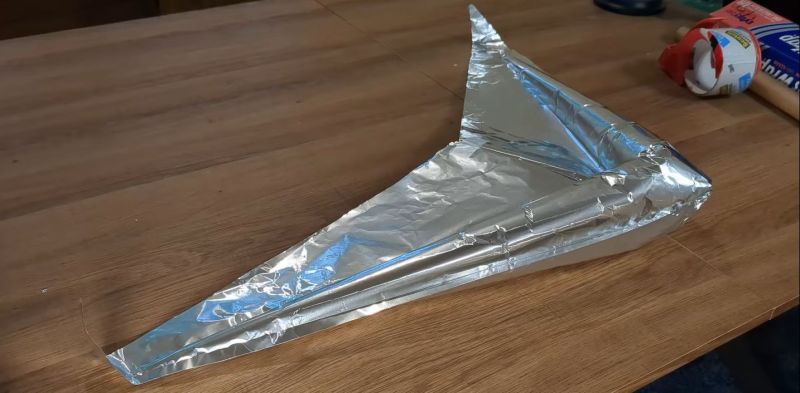Hydroforming is a very effective way to turn a ductile metal like aluminium or stainless steel into a specific shape, either using a die or by creating a closed envelope in which the hydraulic fluid is injected. While trying to think of ways to create a hydroformed airplane without spending big bucks on having it done professionally – or learning to weld sheet metal together with waterproof welds along the seams – [Adrian Perez] decided that using plain aluminium foil as found in the average kitchen might be a good way to get his feet wet here. When stuck together with double-sided tape, the foil is both strong and light enough to be inflated like a party balloon and still fly better than a lead balloon (which do fly, albeit poorly).
The basic design for the initial Luma glider that he assembled is based around a Kline-Fogleman (KA) airfoil. This type of airfoil is mostly characterized by the simplicity of construction, having been devised in the 1960s for paper airplanes. It uses a stepped approach rather than a continuous airfoil and has seen mostly attention in hobby circles. Even if this Luma glider brings to mind the ill-fated Goodyear Inflatoplane, a hydroformed version of these foil prototype gliders would not have to rely on being inflated to function.
For small-scale prototypes, using low-cost aluminium foil or similar to test out shapes before committing to a design to be welded and hydroformed does seem like a useful approach.
















Looking at this guy’s other videos, he’s either burning through a huge backlog of projects, or he’s another Robert Murray-Smith and is going to be an endless font of interesting, if less than practical, ideas. I _really_ hope it’s the latter.
ahhh…it’s the silly Yul Brinner guy again. I like him!
I have sort of been doing something like this. I have all these #10 coffee cans, and they are stacking up as I am a big coffee drinker. I can flatten out the sheet of steel in the vise with OK results, I’d like to make a roller of some kind to do it. Then I 3D print a positive & negative of the shape and squish it in the vise again. I’ve been using papercraft patterns for templates for some models, but the one I finished was just from the STL’s of a V2 rocket. The nose cone is in 3 pieces, formed with the 3D printed stamps and I use one of those little spot welders for rebuilding batteries – I actually bought it to fix a battery, now that’s done and I have this spot welder. So I have a steel V2 rocket sot welded together and it actually looks pretty good. Other more pressing project have distracted me, but I intend to pursue it some more. Probably best suited for building dioramas, like a rusty millenium falcon half buried in sand, but I was also thinking about RC models with unibody construction.
I REALLY want to see that V2. Seriously. That sounds cool.
I thought we used to be able to upload pics here, I had to make an IO page. Please keep in mind it’s not perfect and I’d like to do better next time, this is my first attempt at a spot welded model.
Enjoy
https://hackaday.io/page/395312-spot-welded-v2-for-the-guy-that-wanted-to-see-it
Coffee is still sold in steel cans?
Where?
Walmart, Tops Friendly Market. How’d you miss it?
With spot welders for battery tabs having become rather cheap, I wonder how good the results would be when applying them to roll spot welding:
“Roll Spot Weld 4mil and 1.5mil Aluminum Foil with Sunstone CD Welder and PASP Hand Piece Attachment”
https://www.youtube.com/watch?v=XZejfhTe5is
Having a plotter do the welding would certainly be a bonus.. oh and having the welds be air tight to some degree, of course.
As long as the flow is sufficiently restricted the welding wouldn’t have to be airtight – the pressure will still build up despite the leaks and thus be able to form the material. You’d only really strictly need it to be airtight if you are using the pressure differential to maintain the shape – which with something as thin and soft as most Aluminium foils you may well want to do…
Kitchen aluminum foil has got to be one of the worst alloys (Al 1100-ish) to use, structurally. Flexure strength:weight is abysmal. Short of changing the alloy, is there any way to harden plain aluminum? It doesn’t work-harden very well.
Nope if you’re using kitchen grade, you are stuck with dead soft which is kinda the point.
What about filling with polyurethane foam post forming? It would add rigidity without a lot of weight.
Wow – amazing patience doing all of those by hand.
I can only see disadvantages with glued aluminium foil compared to heat sealed mylar. What am I missing?
Imagine you put two mylar foils on top of each other. Then use a heat sealing cnc/printer. Draw a shape to heat seal a contour, cut off the excess and inflate. I would expect that you can experiment on the shape 10x faster then? Reproducible and such…